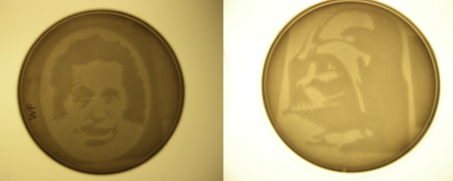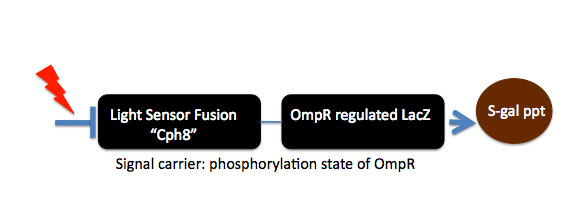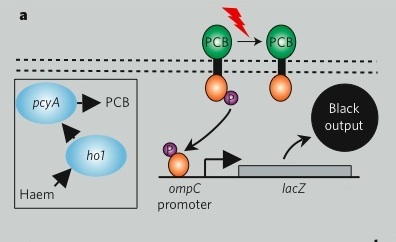Synthetic Biology and the High School Curriculum: Lab 3
|
Lab 1 |
Lab 3: Picture this (coming soon!)ObjectivesBy the conclusion of this laboratory investigation, the student will be able to:
IntroductionPart 1: The bacterial photography systemPart 2: Electronic modelingData TableIn your lab notebook, you will need to construct a data table as shown below. (These may be provided)
ProcedureCalculationsLab ReportPart 3: Taking a pictureData TableIn your lab notebook, you will need to construct a data table as shown below. (These may be provided)
ProcedureCalculationsLab ReportPart 4: What would you design?A Design Proposal:
Introduction These diagrams summarize the mechanism of the bacterial photography system (as explained in part 1). Let’s think in general terms about what happens in this system. The absence of light stimulates a sensor molecule which activates (phosphorylates) a transcription factor which turns on expression of a gene that causes a black molecule to be produced. On the other hand, the presence of light deactivates the transcription factor and inhibits expression of the gene. We can summarize these results using the following truth table: However, the system does not work with 100% inefficiency so some β-gal is produced even in the dark. The actual results might look more like:
Now you may wonder why anyone would want to take black and white photos with bacteria. Sure, the bacteria are smaller than any pixels currently made using conventional technology and can therefore produce sharper images. But, as small as these pixels are, the images are slow to develop and specialized training is required. Be assured, bacteria will not be replacing your camera. This system was created to learn more about the process of biological engineering. The engineers have demonstrated that they can link parts of proteins and control gene expression. So now it is on to greater challenges. For instance, imagine that we could use this pattern, but replace some or all of the parts to design another system. For instance, you could substitute an ORF that would lead to cell movement instead of producing β-gal. Would this produce bacteria that move toward light? What if you wanted bacteria that moved in the opposite direction? What changes would you have to make? What if you wanted bacteria that moved toward a toxin instead of light? And if it moved toward a toxin, what might you want the bacteria to do to it once it found it? Your Task: You will write a proposal to NISB (The National Institute of Synthetic Biology) to convince them to fund the next three years of your research. Think about a problem or challenge that can be addressed through synthetic biology. Perhaps you want to do something to improve the environment, or address a human health issue, or build structures that will make our lives better. Think about a stimulus resulting from this situation. Think about how you would want cells to respond to this stimulus. Think about how that response will be better than any existing technology. Please use your imagination and think big but stay away from science fiction. You are designing an overall system so you do not have to worry about describing individual parts. However, you do need to describe 1) the problem, 2) stimulus and 3) cell output in enough detail to convince the proposal evaluators that you are a knowledgeable, creative, serious candidate for funding. The Proposal: Your proposal should contain the following sections. Your explanations must address, but are not limited to, the following questions. (Approximate length 5-7 pages) Purpose:
Competing technologies:
The design:
Expected results:
Advantages:
Potential problems:
Testing:
Design project rubric ( pdf )
Navigation
|




